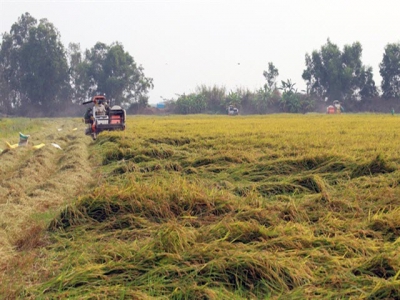Kiên Giang develops rice co-operative – company links to ensure demand, supply

KIÊN GIANG — Kiên Giang Province, the country’s largest rice producer, has taken measures to strengthen co-operation between co-operatives and companies involved in rice production to improve the quality and value of the grain, and thus farmers’ incomes.
Harvesting the 2019-20 winter – spring crop in Kiên Giang Province’s Giang Thành District. — VNA/VNS Photo Lê Huy Hải
The province’s Co-operative Alliance and other relevant agencies have acted as a link between them.
Nguyễn Văn Thể, deputy chairman of the alliance, said under the contracts companies invest in seeds, inputs and advanced farming techniques for their contracted rice co-operatives, but many also help the latter improve their management.
Co-operative members do not have worry about fluctuating prices and demand after they sign contracts while companies can secure the quantity of quality rice needed for their exports.
In the Cửu Long (Mekong) Delta province, farmers used to suffer from price declines in case of a bumper harvest while companies found it hard to buy enough quality rice since both depended on traders.
Now 219 co-operatives with a total of 37,272ha have signed contracts with companies, according to the alliance.
They include 34 large-scale rice fields created by pooling lands to achieve economies of scale with a total of 19,000ha in the 2019-20 winter – spring crop.
Mai Anh Nhịn, deputy chairman of the provincial People’s Committee, said farmers had a bumper harvest and good prices since authorities and farmers took proactive measures to mitigate the severe saltwater intrusion.
Farmers harvested an average yield of 7.24 tonnes per hectare, 300kg more than a year earlier.
Đoàn Văn Bấu, director of the Thạnh Hòa Agriculture Co-operative in Châu Thành District, said to achieve this, the co-operatives and local agricultural officials taught farmers many advanced techniques, including proper use of fertilisers and pesticides.
In the ongoing summer – autumn crop, the province plans to grow 284,000ha and harvest 1.5 million tonnes of paddy, according to its Department of Agriculture and Rural Development.
The department has instructed farmers to grow high-quality varieties on 85 per cent of the area and medium-quality varieties on the remaining 15 per cent.
Đỗ Minh Nhựt, deputy director of the department, said the province has supported more companies, co-operatives and co-operative groups to produce rice under the large rice field model to improve quality and secure outlets.
In Vĩnh Thuận District, the provincial and district agriculture extension agencies are helping four large rice fields of 230ha each grow clean rice and reduce production costs.
Participating farmers are provided with a subsidy of VNĐ720,000 (US$31) per hectare for buying certified seeds and VNĐ1.26 million ($54) per hectare for buying organic fertilisers and pesticides.
They are taught the “3 reductions and 3 increases” techniques to reduce the use of seeds, fertilisers and plant protection chemicals and to achieve increases in productivity, quality and efficiency.
The project aims to reduce production costs by 10-20 per cent and improve yields by 10-15 per cent.
Có thể bạn quan tâm
 VN's rice exports bounce back after one-month interruption
VN's rice exports bounce back after one-month interruption While exports of many products have plunged because of Covid-19, rice exports are growing, with prices of some products reaching an 8-year high.
 China remains major market for Vietnam’s farm produce
China remains major market for Vietnam’s farm produce The first consignments of litchis grown in Hai Duong province shipped to Singapore hit the newspapers, and, in the past, local newspapers
 Việt Nam's coffee exports up in H1
Việt Nam's coffee exports up in H1 Việt Nam exported 955,000 tonnes of coffere, worth US$1.6 billion, in the first six months of 2020